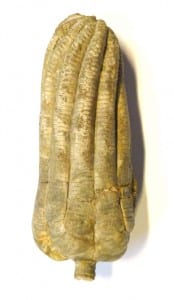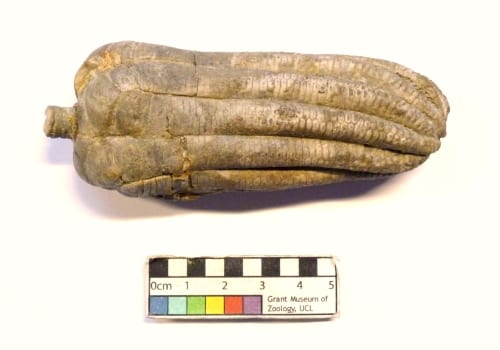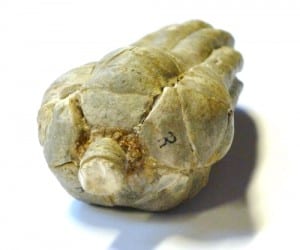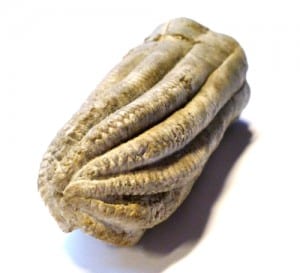Specimen of the Week 220: The Fossil Sea Lily
By Tannis Davidson, on 28 December 2015
It is perhaps no surprise that during December, most of the specimens featured in this blog tend to have associations with wintery Christmastime animals. There has been a reindeer, a polar bear, a robin, an owl and (last week) a partridge – all of which have been highlighted to kindle the yuletide cheer.
In a radical departure, here’s a specimen that has absolutely no connection to winter, snow or any December seasonal holiday. But does it bring joy? Yes. This is an amazing specimen. Would this be a great Christmas present? Absolutely. If you ever see one, keep me in mind.
Here it is – the one you’ve been waiting for – this week’s Specimen of the Week is the…
**Fossil Crinoid**
1. Through oceans of time
This specimen is a fossil crinoid (also known as a ‘sea lily’). Crinoids are marine animals related to sea urchins and starfish within the phylum Echinodermata. The first crinoids appeared in the Ordovician period (485-443 million years ago) and today there are around 600 extant species.
Our Specimen of the Week dates from the middle Triassic period (around 230 million years ago). Encrinus liliiformis emerged as life returned following the Permian-Triassic extinction (252 million years ago). Also know as the ‘Great Dying’, this was/is the Earth’s most severe extinction event whereby 96% of all marine species and 70% of terrestrial species died out. As marine organisms, crinoids greatly suffered during this extinction and only one genus, Isocrinus survived to become the root of the recovery of Triassic crinoids.
2. Muschelkalk specimen
During the Middle Triassic, most of modern-day Germany was covered with an inland sea. Fossils from this period are predominantly found in the sequence of sedimentary rock strata known as the Muschelkalk Formation. The German ‘mussel chalk’ formation – named for its characteristic beds of fossil shells – is subdivided into three groups: Upper, Middle and Lower Muschelkalk. Crinoids are found in here in abundance and a portion of the Upper Muschelkalk is made up almost entirely of the fragmentary stems of E. liliiformis.
3. Structure
This fossil is only part of the animal – the calyx and arms. E. liliiformis had a five-fold radial symmetry and consisted of:
1. a root-like ‘holdfast’ which fastens the animal to the sea floor
2. a stem made up from individual ossicles
3. a calyx (cup-like structure) consisting of 2 or 3 rows of plates
4. arms (or branches) which extend from the calyx
5. pinnicles (feather-like growths extending from the arms for filter feeding)
Although the arms of our specimen have closed in their final, elegant position, the preservation of the specimen is so fine (and life-like) one can easily imagine the unfurling of the arms and their movement underwater.
4. Old man in the sea
Another significant extinction event at the end of the Triassic period (the Triassic-Jurassic extinction) marked the end of E. liliiformis. Luckily for us, extinct crinoids are found in the fossil record due to the fact that they were marine animals (good environment for fossilisation) and that their ‘skeletons’ were made of calcareous plates (thus they have the raw material for diagenesis to occur).
Fast forward hundreds of millions of years to late 19th century Germany when our fossil was found. We’re not sure exactly where it came from or the date of discovery but it has been a part of the collection at the Grant Museum since at least 1890 where it appears in the Museum’s first catalogue:
5. Living fossil
Hopefully all of this talk of fossils and mass extinctions has not dampened your seasonal joy. As mentioned above, there are around 600 living species of crinoids living in the depths of our oceans – living fossils related to the fossil specimen highlighted here. Despite their delicate appearance, crinoids are hearty survivors – living through 485 million years of upheaval, change and evolution.
![By Alexander Vasenin (Own work) [CC BY-SA 3.0 (http://creativecommons.org/licenses/by-sa/3.0)], via Wikimedia Commons](https://blogs.ucl.ac.uk/museums/files/2015/12/Crinoid_on_the_reef_of_Batu_Moncho_Island-225x300.jpg)
Crinoid on the reef of Batu Moncho Island (near Komodo, Indonesia).By Alexander Vasenin, CC BY-SA 3.0 Wikimedia Commons
Tannis Davidson is Curatorial Assistant at the Grant Museum of Zoology
2 Responses to “Specimen of the Week 220: The Fossil Sea Lily”
- 1
-
2
Melinda Whitmer wrote on 15 October 2020:
I need this fossil authenticated please. Can any one help me. ?
 Close
Close







I have great interest in this. I have found walking in creek , one beautifully preserved crinoid. If there is more information about this find I would love to know.